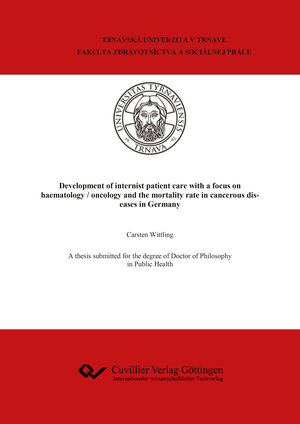Development of internist patient care with a focus on haematology / oncology and the mortality rate in cancerous diseases in Germany
von Carsten WittlingThe medical care structures in Germany are the result of a needs-planning and control in the outpatient and inpatient service provision. Good access, distribution optimization as well as high quality of medical services should be attributes which guarantee a future-oriented needbased health care to the population. But the health care system in Germany is characterized by serious allocation problems. This is particularly evident between rural and urban regions as well as between federal states. In the area of outpatient care, the legislators intervened by passing the GKV Health Care Enhancing Law (GKV-VSG). The concerned federal states are responsible for balancing out the care differences in the inpatient area.
Internists for hematology/oncology are taking up malignant new strains, known in common parlance as cancer. Their number increased between 2010 and 2014 by 11.7 %. The increasing incidence and prevalence rates are the possible drivers of this development. Stronger in the outpatient statutory health care than in inpatient service provision. Some federal states recorded an increase in this area while other states registered a decrease. What is interesting here is: federal states with less poverty in which household assets are distributed unequally, employ a bigger number of internists for hematology/oncology than others. This unequal development is not without its consequences. Besides age and gender-specific differences in mortality from malignant new strains, the richer federal states tend to have lower mortality rates.
The present thesis generates initial results on whether the (regional) development of internists for hematology/oncology could play a role in determining mortality in case of malignant diseases of the blood, malignant diseases of the lymph nodes and the lymphatic system as well as malignant solid tumours or their groups. Statistical methods will be used to verify or falsify the formulated hypotheses for describable and usable outcomes.
Internists for hematology/oncology are taking up malignant new strains, known in common parlance as cancer. Their number increased between 2010 and 2014 by 11.7 %. The increasing incidence and prevalence rates are the possible drivers of this development. Stronger in the outpatient statutory health care than in inpatient service provision. Some federal states recorded an increase in this area while other states registered a decrease. What is interesting here is: federal states with less poverty in which household assets are distributed unequally, employ a bigger number of internists for hematology/oncology than others. This unequal development is not without its consequences. Besides age and gender-specific differences in mortality from malignant new strains, the richer federal states tend to have lower mortality rates.
The present thesis generates initial results on whether the (regional) development of internists for hematology/oncology could play a role in determining mortality in case of malignant diseases of the blood, malignant diseases of the lymph nodes and the lymphatic system as well as malignant solid tumours or their groups. Statistical methods will be used to verify or falsify the formulated hypotheses for describable and usable outcomes.







